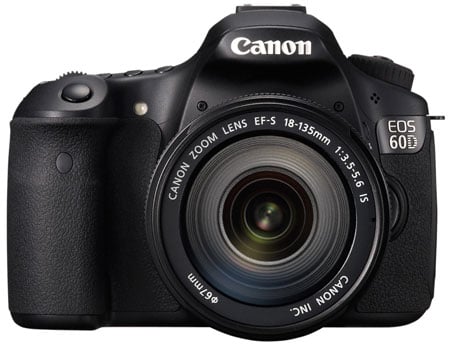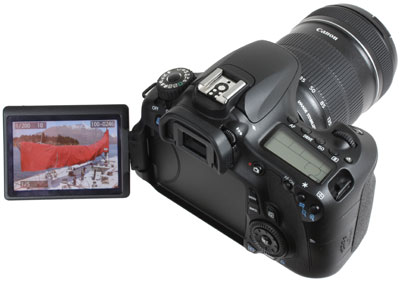Canon EOS 60D
-
-
Written by Gordon Laing
Intro
The Canon EOS 60D is a mid-range DSLR featuring 18 Megapixels, HD video and a fully-articulated screen. Announced in August 2010, it’s the official replacement for the EOS 50D, but Canon’s repositioned the new model from the semi-pro status of its predecessor into a new mid-range category for the company. As such the EOS 60D sits in-between the upper entry-level EOS 550D / T2i and the semi-pro EOS 7D, allowing it to directly compete against Nikon’s highly successful mid-range DSLRs like the D90 and D7000.
This repositioning has caused some heartache for existing xxD owners who were waiting for a semi-pro upgrade from models like the EOS 40D and EOS 50D. While EOS 60D offers several key enhancements over these models, the repositioning has also seen a number of ‘downgrades’, most notably concerning the body construction and removal of certain specialist features.
So while Canon officially describes the EOS 60D as the successor to the EOS 50D, we’d say the most sensible path for xxD owners who want an upgrade in every respect is to go for the existing EOS 7D instead – it may be a year older than the 60D, but remains a great camera with a price that improves the longer it’s been out; see our Canon EOS 7D review for more details. As for the new EOS 60D, it’s the ideal choice for someone wanting a step-up from an entry-level DSLR without the expense, weight or complication of a traditional semi-pro model. Think of it as a souped-up EOS xxxD / Rebel and it makes much more sense – and once again this repositioning finally gives Canon a DSLR to directly compete against Nikon’s highly successful mid-range models rather than slotting-in above or below.
 |
So repositioning aside, what’s new on the EOS 60D? Like many new Canon DSLRs, the EOS 60D borrows elements from existing models and repackages them with at least one brand new feature. Starting with the sensor, the EOS 60D inherits the same 18 Megapixel resolution as the EOS 7D and EOS 550D / T2i, along with the same 100-6400 ISO sensitivity range, expandable to 12,800 ISO. Note the resolution may be the same as the EOS 7D, but the 7D’s sensor features double the data channels, which coupled with its dual DIGIC 4 processors and quicker mechanics, allows it to support faster continuous shooting. Canon describes the image quality of the EOS 60D, EOS 7D and EOS 550D / T2i as being essentially the same though.
With much the same sensor electronics, it’s not surprising to find the EOS 60D also sporting the same HD movie modes as the EOS 7D and EOS 550D / T2i. As such, the EOS 60D can shoot Full HD 1080p video at 24, 25 or 30fps, along with 720p HD or VGA video at 50 or 60fps; the EOS 60D also inherits the Movie Crop option of the 550D / T2i, which records the central 640×480 pixel area of the sensor, delivering standard definition movies with around seven times magnification compared to shooting with the entire frame.
The EOS 60D also features an external microphone input, but unlike previous models allows its wind filter to be applied to both internal or external microphones; it also follows the firmware-updated EOS 5D Mark II to become the second Canon DSLR offering manual adjustment of audio levels, a feature that’s not even on the EOS 7D (at the time of writing anyway). The EOS 60D additionally inherits the 63-zone metering system of the EOS 7D and EOS 550D / T2i, along with the wireless flash control and electronic levelling gauge of the 7D, although downgrades the latter to a single axis tilt and relies on the EV scale to indicate it through the viewfinder.
The EOS 60D also inherits the excellent 3in / 1040k dot / 720×480 pixel screen first seen on the EOS 550D / T2i, which employs a 3:2 aspect ratio that matches the native shape of its sensor. Previous Canon DSLRs – and indeed most rival models – used squarer 4:3 aspect ratio screens which meant images in Live View or playback had black bars above or below when the entire frame was viewed. Now on the EOS 60D, images in Live View or playback fill the screen and exploit the full display resolution.
So far so good, but they’re all features we’ve seen on the existing EOS 7D and EOS 550D / T2i. The major new feature of the EOS 60D is that the superb screen becomes the first on a Canon DSLR to be fully-articulated. This allows it to twist and flip in any direction, for easy composition at high or low angles, along with folding out to face the photographer or back on itself for protection. This feature will be greatly appreciated by anyone who shoots movies or in Live View. There’s also in-camera processing of RAW files and a selection of Creative Filters which can be applied to images in Playback.
|
At this point it’s worth noting all of the above are upgrades to the EOS 50D. Anyone switching from the 50D to the 60D will therefore enjoy higher resolution images, a selection of HD movie modes with support for external microphones, wireless flash control, more sophisticated metering, in-camera RAW processing and a screen which not only flips and twists to any angle, but which is also optimised for the native image shape. All worthy upgrades, so why are existing 50D owners so upset?
The reason is Canon has kept some features the same while downgrading others. The EOS 60D’s nine cross-type AF system appears to be the same as that on the 50D, as does its viewfinder (despite fractionally differing specifications).
The continuous shooting speed has however decelerated from 6.3fps on the EOS 50D to 5.3fps on the EOS 60D, and while the RAW buffer remains 16 frames, the JPEG buffer has fallen from around 90 to 58 shots. The PC Sync port for connecting to external studio lights has been removed, as has AF micro-adjustment to compensate for lenses which suffer from front or back-focusing. The EOS 60D also switches from Compact Flash to SD memory, which along with a change in battery (and therefore also the grip) means xxD owners won’t be able to reuse many accessories.
Probably the greatest annoyance to xxD owners though is the change in body construction from magnesium alloy to a plastic shell over a metal frame. As such while the shape and texture of the 60D is similar to its semi-pro predecessors, the materials used in its construction are the same as those on entry-level bodies like the EOS 550D / T2i. The upper screen is also smaller than previous xxD models.
 |
Now this isn’t all bad news as it means the EOS 60D is 8% lighter than its predecessor and also hits a lower price point on launch, but there’s no getting away from the fact existing xxD owners will lose their magnesium alloy bodies, PC Sync ports and (on the 50D anyway) AF micro-adjustment, while also suffering from slower continuous shooting not to mention a change in memory and batteries. This is why we’d recommend existing xxD owners wanting an upgrade go for the EOS 7D instead as it represents an upgrade across the board, although obviously if that xxD owner is willing to sacrifice some semi-pro features in favour of lighter body with video and a flexible screen, the 60D could still represent a good choice.
Coming in the other direction though, the EOS 60D offers a great deal for anyone looking for a step-up from an entry-level model. They’ll get a more comfortable body with a bigger, brighter penta-prism viewfinder, an AF system where all nine points are cross-type, an upper LCD information screen and faster continuous shooting. They’ll also enjoy a large and detailed screen, and the only one that’s fully-articulated in Canon’s range.
Revealingly this is a similar pitch to Nikon’s mid-range DSLRs, which have long offered a number of classier features over entry-level models without the cost, weight and complexity of a semi-pro body. Best-selling models like the D80 and D90 proved it to be a very successful strategy for Nikon and one which Canon has obviously been keen to replicate. Indeed the EOS 60D seems designed almost in direct response to the D90, while trumping it with an articulated screen and 1080p movies. But the D90 is two years older and Nikon hasn’t stood still. Canon’s EOS 60D faces a brand new rival in the form of the new D7000.
In our full review of the Canon EOS 60D we’ll take a close look at the performance and features of this new model compared to other DSLRs in Canon’s range, along with its key rival, the Nikon D7000. The mid-range DSLR category is one of the most exciting right now, so if you’re looking for a step-up from an entry-level model, you’ve come to the right place.
Testing notes
We tested a final production EOS 60D running firmware 1.0.5. Following our convention of testing cameras using their factory default settings unless otherwise stated, the EOS 60D was set to Large Fine JPEG plus RAW quality, Auto White Balance, Evaluative metering and the Standard Picture Style; unless otherwise stated, High ISO Noise Reduction and the Auto Lighting Optimiser were set to their default Standard settings, while Highlight Tone Priority was disabled. Note: we disabled Auto Lighting Optimizer for our high ISO noise tests, as this can artificially increase noise levels. Lens-based Image Stabilisation was enabled for all handheld shots and disabled for tripod-based tests.





